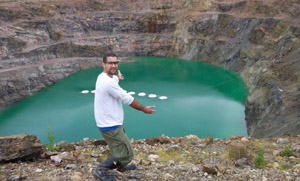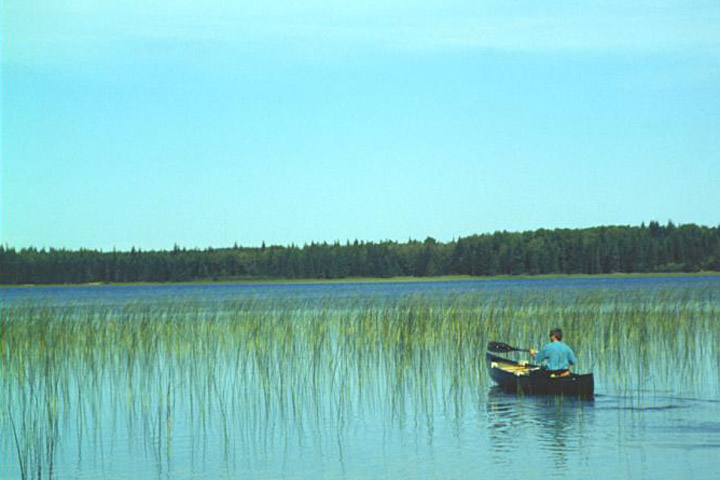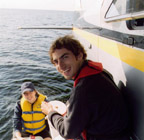
Jeff Hudson BSc, MSc, PhD
Professor Emeritus Department of Biology, Limnology Lab- Address
- CSRB 320.4
Setting
Some of the most diverse lake systems of North America can be found within a two-hour driving radius of the University of Saskatchewan (e.g., low to high salinity, ultra-oligotrophic to hypereutrophic, and low to high DOC systems). Our comparative and experimental studies benefit immensely from the close proximity of these diverse lakes.
|
Bioremediation at DJX Pit Cluff Lake |
Sampling Trappers Lake Prince Albert National Park |
|
Sampling Reindeer Lake in Northern Saskatchewan |
Example of dissolved organic carbon (tea color) in stream water |
Research
The general theme of research in the limnology laboratory revolves around biogeochemical cycles in aquatic ecosystems. Projects include the effects of food web structure, ultraviolet radiation, climate change and biodiversity on elemental cycling and energy flow.
1. A major research focus is examining the sensitivity of Lake Diefenbaker to nutrients under a changing climate. The project consists a variety of nutrient related studies: a nutrient mass balance model, a nutrient sufficiency-deficiency study, a nutrient sourcing study, a water quality study (pathogens and cyanotoxins), a remote sensing initiative, and so forth. This program is funded by the Saskatchewan Water Security Agency and the Global Institute for Water Security. The video below provides an introduction to this important study:
2. A second major initiative is examining the effect of ultraviolet radiation on food webs and the biogeochemisrty of C, N, and P in lakes. An adjacent study is investigating the effect of climate on the long-term carbon cycle in lakes.
3. A final project is examining the effect of climate change (drought) on Prairie lake ecosystems.
Additional areas of longstanding research include the development of methods for the estimation of nutrients at picomolar concentrations (e.g., P), and the factors (e.g., food web structure, temperature, stoichiometry, pH, and salinity) that affect the cycling efficiency of elements in food webs.
Aquatic Resources
Publications
Imtiazy, M. N., A. M. Paterson, S. N. Higgins, H. Yao, D. Houle, and J. J. Hudson. 2025. Has lake brownification ceased? Stabilization, re-browning, and other factors associated with dissolved organic matter trends in eastern Canadian lakes. Water Research 269: 122814. https://doi.org/10.1016/j.watres.2024.122814
Imtiazy, M. N., K. Hunter, and J. J. Hudson. 2024. In-reservoir transformation of dissolved organic matter as a function of hydrological flow. Journal of Environmental Management.
https://doi.org/10.1016/j.jenvman.2024.120099
Chakraborty, P., A. Manek, S. Chakraborty, J. Hudson, S. Niyogi. 2023 Investigating the combined effects of pH changes and UV radiation exposure on dissolved metal-humate complexes: an important process in aquatic systems. Environ Sci Pollut Res. https://doi.org/10.1007/s11356-023-26178-z
Imtiazy, M. N., K. Hunter, J. Sereda, L. Dirk, and J. J. Hudson. 2023. Effects of regional climate, hydrology and river impoundment on long-term patterns and characteristics of dissolved organic matter in semi-arid northern plains rivers. Science of the Total Environment. https://doi.org/10.1016/j.scitotenv.2023.161961
Abirhire, O., J. M. Davies, N. Imtiazy, K. Hunter, S. Emmons, J. Beadle, and J. Hudson. 2023. Response of phytoplankton community composition to physicochemical and meteorological factors under different hydrological conditions in Lake Diefenbaker. Science of the Total Environment. https://doi.org/10.1016/j.scitotenv.2022.159210
Sadeghian, A., Hudson, J. and Lindenschmidt, K. 2021. Effects of quality controlled measured and re-analyzed meteorological data on the performance of water temperature simulations. Hydrological Sciences Journal. 67: 21-39. https://doi.org/10.1080/02626667.2021.1994975
Imtiazy, M. N., A. M. Paterson, S. N. Higgins, H. Yao, S. Couture, and J. J. Hudson. 2020. Dissolved organic carbon in eastern Canadian lakes: Novel patterns and relationships with regional and global factors. Science of the Total Environment. https://doi.org/10.1016/j.scitotenv.2020.138400
Abirhire, O., J. M. Davies, X. Guo and J. Hudson. 2020. Understanding the factors associated with long-term reconstructed turbidity in Lake Diefenbaker from Landsat-imagery. Science of the Total Environment. https://doi.org/10.1016/j.scitotenv.2020.138222
Abirhire, O., K. Hunter, J. M. Davies, X. Guo, D. de Boer and J. Hudson. 2019. An examination of the long-term relationship between hydrologic variables and summer algal biomass in a large Prairie reservoir. Canadian Water Resources Journal. 44:79-89
Sadeghian, A., S. C. Chapra, J. Hudson, H. Wheater, and K. Lindenschmidt. 2018. Improving in-lake water quality modeling using variable chlorophyll a/algal biomass ratios. Environmental Modelling & Software 101: 73-85.
Sadeghian, A., J. Hudson, H. Wheater, and K. Lindenschmidt. 2017. Sediment plume model-a comparison between use of measured turbidity data and satellite images for model calibration. Environmental Science and Pollution Research. 24:19583-19598.
Doig, L., R. North, J. Hudson, C. Hewlett, K. Lindenschmidt and K. Liber. 2017. Phosphorus release from sediments in a river-valley reservoir in the northern Great Plains of North America. Hydrobiologia 787:323-339.
Abirhire, O., R. North, K. Hunter, D. Vandergucht, and J. Hudson. 2016. Do human activities affect phytoplankton biomass and composition in embayments on Lake Diefenbaker? Freshwater Ecology 31:597-608
Dubourg, P., R. North, K. Hunter, D. Vandergucht, O. Abirhire, G. Silsbe, S. Guildford, J. Hudson. 2015. Light and nutrient co-limitation of phytoplankton communities in a large reservoir: Lake Diefenbaker, Saskatchewan, Canada. Journal of Great Lakes Research 41 (supplement 2):129-143
Sadeghian, A., D. de Boer, J. Hudson, H. Wheater, K. Lindenschmidt. 2015. Lake Diefenbaker temperature and mixing model. Journal of Great Lakes Research 41 (supplement 2): 8-21
North, R., L. Doig, K. Lindenschmidt, J. Davies and J. Hudson. 2015. Lake Diefenbaker: the prairie jewel. Lake Diefenbaker, Saskatchewan, Canada. Journal of Great Lakes Research 41 (supplement 2): 1-7
Hudson, J. and D. Vandergucht. 2015. Spatial and Temporal Patterns in Physical Properties and Dissolved Oxygen in Lake Diefenbaker, a Large Reservoir on the Canadian Prairies. Journal of Great Lakes Research 41 (supplement 2): 22-33
Abirhire, O., R. North, K. Hunter, D. Vandergucht, J. Sereda and J. Hudson. 2015. Environmental factors influencing phytoplankton communities in Lake Diefenbaker, Saskatchewan, Canada. Journal of Great Lakes Research 41 (supplement 2):118-128
North, R., J. Johansson, D. Vandergucht, L. Doig, K. Liber, K. Lindenschmidt, H. Baulch and J. Hudson. 2015. Evidence for internal phosphorus loading in a large prairie reservoir (Lake Diefenbaker, Saskatchewan). Journal of Great Lakes Research 41 (supplement 2): 91-99
Maavaraa, T., J. Hood, R. North, L. Doig, C. Parsons, J. Johansson, K. Liber, J.J. Hudson, B. Lucas, D. Vandergucht, P. Van Cappellen. 2015. Reactive silicon dynamics in a large prairie reservoir (Lake Diefenbaker, Saskatchewan). Journal of Great Lakes Research 41 (supplement 2): 100-109
Yip, H.D., Johansson J., Hudson J. J. 2015. A 29-year assessment of the water clarity and chlorophyll-a concentration of a large reservoir: Investigating spatial and temporal changes using Landsat imagery. Journal of Great Lakes Research 41 (supplement 2): 34-44
Hewlett, C., R. L. North, J. Johansson, D. Vandergucht, J. Hudson. 2015. Contribution of shoreline erosion to nutrient loading of the Lake Diefenbaker reservoir, Saskatchewan, Canada. Journal of Great Lakes Research 41 (supplement 2): 110-117
Chakraborty, P., Manek, A., Niyogi, S., Hudson, J. 2014. Determination of Dynamic Metal Complexes and their Diffusion Coefficients in the Presence of Different Humic Substances by Combining Two Analytical Techniques. Analytical Letters 47:1224-1241
North, R.L., Khan, N.H., Ahsan, M., Prestie, C., Korber, D.R., Lawrence, J.R., Hudson, J.J. 2014. Relationship between water quality parameters and bacterial indicators in a large prairie reservoir: Lake Diefenbaker, SK, Canada. Canadian Journal of Microbiology 60: 243-249.
Vandergucht, D., J. Sereda, J. Davies and J. Hudson. 2013. A comparison of phosphorus deficiency indicators with steady state phosphate in lakes. Water Research. 47:1816-1826 http://dx.doi.org/10.1016/j.watres.2013.01.004
Sereda J., K. Hunter, D. Vandergucht, and J. Hudson. 2012. Photochemical Mineralization of Dissolved Organic Nitrogen to Ammonia in Prairie Lakes. Hydrobiologia 693:71-80
Sereda J., D. Vandergucht, and J. Hudson. 2012. In situ UVA exposure modulates change in the uptake of radiophosphate in size fractionated plankton assemblages following UVR exposure. Microbial Ecology 63:751-760
Sereda J. , D. Vandergucht and J. Hudson. 2011. Disruption of planktonic phosphorus cycling by ultraviolet radiation. Hydrobiologia . 665:205-217 doi:10.1007/s10750-011-0623-6
Sereda J. and J. Hudson. 2011. Empirical models for predicting the excretion of nutrients (N and P) by aquatic metazoans: taxonomic differences in rates and element ratios. Freshwater Biology. 56:250-263
Sereda, J. , M. Bogard, J. Hudson, T. Dessouki, and D. Helps. 2011. Climate warming and the onset of salinization: rapid changes in the limnology of two northern plains lakes. Limnologica 41:1-9.
Sereda, J. and J. Hudson. 2010 A comparative estimate of P fluxes in lakes: A comment on “Fish decomposition in boreal lakes and biogeochemical implications” by Chidami and Amyot (2008). Limnology and Oceanography. 55:463-465.
Zhang, J., J. Hudson , R. Neal, J. Sereda, T. Clair, M. Turner, D. Jeffries, P. Dillon, L. Molot, K. Somers and R. Hesslein. 2010. Long-Term Patterns of Dissolved Organic Carbon in Lakes across Eastern Canada: Evidence of a Pronounced Climate Effect. Limnology and Oceanography 55:30-42
Sereda, J., J. Hudson, W. Taylor. 2009. Abiotic Effects of UV on Planktonic P Kinetics. Aquatic Sciences 71:127-134.
Sereda, J., J. Hudson, P. McLoughlin. 2008. General empirical models for predicting the release of nutrients by fish, with a comparison between detritivores and non-detritivores. Freshwat. Biol. 53:2133-2144
Sereda, J., J. Hudson, W. Taylor and E. Demers. 2008. Fish as sources and sinks of nutrients in lakes. Freshwat. Biol. 53:278-289
Hudson, J. and Taylor, W. (2005). Rapid estimation of phosphate at picomolar concentrations in freshwater lakes with potential application to P-limited marine systems. Aquat. Sci. 67:316-325.
Dessouki, T., J. Hudson, R. Neal and M. Bogard . 2005. The effects of phosphorus additions on the sedimentation of contaminants in a uranium mine pit-lake. Wat. Res. 39:3055-3061.(PDF)
Molot, L., J. J. Hudson, P. J. Dillon and S. A. Miller. 2005. Effect of pH on photo-oxidation of dissolved organic carbon by hydroxyl radicals in a coloured, softwater stream. Aquat. Sci. 67:139-195
Hudson, J., and W. Taylor. 2005. Phosphorus sedimentation during stratification in two small lakes. Arch. Hydrobiol. 162:309-325.
Hudson, J. J., P. J. Dillon and K. M. Somers (2003). Long-term patterns in dissolved organic carbon in boreal lakes: the role of incident radiation, precipitation, temperature, southern oscillation, and sulfate deposition (acid precipitation). Hydrology and Earth System Science 7:390-398.(PDF)
Hudson, J. J., W. D. Taylor, D. J. McQueen and K. M. Somers. 2001. Phosphorus in pelagic food webs. - Part 10 of the Dorset food web piscivore manipulation project. - Arch. Hydrobiol. Spec. Issues Advanc. Limnol. 56:211-225.
Dillon, P. J., D. J. McQueen, C. W. Ramcharan, N. D. Yan and J. J. Hudson. 2001. Changes in nutrient and ion chemistry. - Part 12 of the Dorset food web piscivore manipulation project. - Arch. Hydrobiol. Spec. Issues Advanc. Limnol. 56:227-255.
Hudson, J., W. Taylor and D. Schindler. 2000. Phosphate concentration in lakes. Nature 406: 54-56 (PDF)
Hudson, J., W. Taylor and D. Schindler. 1999. Planktonic nutrient regeneration and cycling efficiency in temperate lakes. Nature 400: 659-661.(PDF)
Wilhelm, F., J. Hudson and D. Schindler. 1999. Contribution of Gammarus lacustris to phosphorus recycling in a fishless alpine lake. Can. J. Fish. Aquat. Sci. 56: 1679-1686.
Rosenfeld, J., and J. Hudson. 1997. Primary production, bacterial production, and invertebrate biomass in pools and riffles in southern Ontario streams. Arch. Hydrobiol. 139:301-316.
Hudson, J., and W. Taylor. 1996. Measuring dissolved phosphorus regeneration in planktonic communities. Limnol. Oceanogr. 41:1560-1565.
Hudson, J., J. Roff and B. Burnison. 1992. Bacterial productivity in forested and open streams in southern Ontario. Can. J. Fish. Aquat. Sci. 49:2412-2422.
Hudson, J., J. Roff and B. Burnison. 1990. Measuring epilithic bacterial production in streams. Can. J. Fish. Aquat. Sci. 47:1813-1820.
Rowe, L., J. Hudson, and M. Berrill. 1988. Hatching success of mayfly eggs at low pH. Can. J. Fish. Aquat. Sci. 45:1649-1652.
Berrill, M., L. Rowe, L. Hollett, and J. Hudson. 1987. Response of some benthic arthropods to low pH. Annals of the Royal Zoological Society of Belgium 117:117-128.
Hudson, J. and M. Berrill. 1986. Tolerance of low pH exposure by the eggs of Odonata (Dragonflies and Damselflies). Hydrobiologia 140:21-25.
Berrill, M., L. Hollett, A. Margosian, and J. Hudson. 1985. Variation in tolerance to low environmental pH by the crayfish Orconectes rusticus, O. propinquus, and Cambarus robustus. Can. J. Zool. 63:2586-2589.
Reports and Non-Peer Reviewed Publication
Hudson, J. 2016. Limnology of the prairie jewel: Lake Diefenbaker. Society of Canadian Limnologists. The Current. Iss. 9, May 20. Pages 3-4.
Sadeghian, A., Hudson, J., Wheater, H. & Lindenschmidt, K.-E. 2014. Water quality modelling of Lake Diefenbaker. Canadian Resources Association. News 33(2): 17-20
Bogard, M. and J. Hudson. 2004. Historical trends and nutrient status of Jackfish Lake with additional comments on Murray Lake. For: The Stewards of Jackfish and Murray Lakes, North Battleford. 28 pages.





